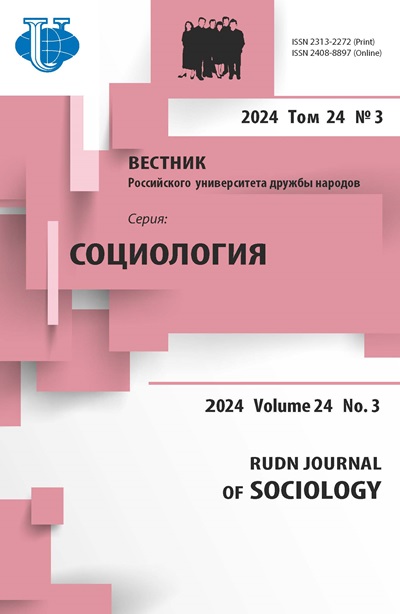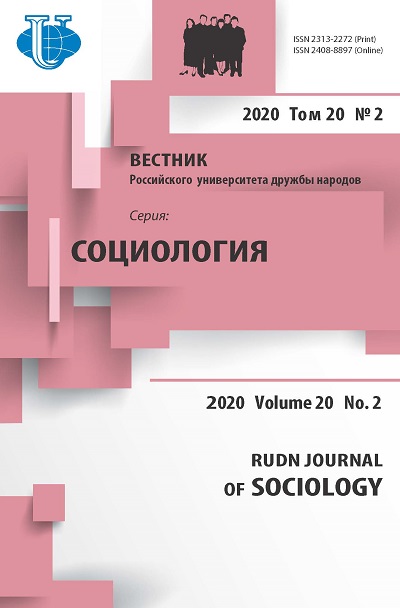Переключение кодов в компьютерно-опосредованной коммуникации
- Авторы: Даргинавичене И.1, Игнотайте И.2
-
Учреждения:
- Вильнюсский технический университет Гедимина
- Клайпедский университет
- Выпуск: Том 20, № 2 (2020)
- Страницы: 405-415
- Раздел: Социологический лекторий
- URL: https://journals.rudn.ru/sociology/article/view/23879
- DOI: https://doi.org/10.22363/2313-2272-2020-20-2-405-415
Цитировать
Полный текст
Аннотация
Большинство исследователей признают, что переключение кодов - это процесс чередования языков, стилей речи и т.д. Сегодня большинство людей в мире многоязычны, часто вариативно смешивают языки, на которых говорят, что делает переключение кодов довольно распространенным явлением. Переключение кодов задействует правительственные, культурные, религиозные и прочие контексты, т.е. частота переключения в мультиязычных коммуникациях является признаком распространенности многоязычия в мире. Онлайн-коммуникация способствует возникновению коммуникативных практик, содержащих условия для переключения кодов и сигнализирующих о вербальном поведении многоязычных сообществ. Переключение кодов влияет на визуальность языка и его образность - незаменимые средства социального конструирования действительности. Способы использования языка обеспечивают коммуникационную эффективность и влияют на выражение новых лингвистических значений. Цель статьи - обозначить особенности переключения кодов в цифровой коммуникации, для чего в социальных сетях Instagram, YouTube, Facebook и Twitter было отобрано и проанализировано восемь примеров. В каждом случае рассматривались грамматика, орфография и пунктуация как литовских, так и английских слов, а также использование элементов английского языка с переключением кодов, специальные символы, аббревиатуры, эмоции и другие особенности интернет-языка. Согласно полученным данным общение в Интернете не является полностью текстовым, так как, используя различные средства составления текста, авторы сообщений делают кодовые элементы английского языка более заметными и изменяют визуальный вид текстов. Эти приемы взаимодействуют с особенностями социальных сетей и, похоже, меняются в соответствии с тенденциями популярной интернет-культуры.
Об авторах
Ирена Даргинавичене
Вильнюсский технический университет Гедимина
Автор, ответственный за переписку.
Email: idargintt@gmail.com
доктор филологических наук, профессор Центра изучения языка
ал. Саулетеке, 11, LT-10223, Вильнюс, ЛитваИндре Игнотайте
Клайпедский университет
Email: indersmbox@gmail.com
докторантка кафедры филологии
ул. Г. Мантас, 84, LT-92294, Клайпеда, ЛитваСписок литературы
- Adams J.N., Swain S. Introduction. Adams J.N., Janse M., Swain S. (Eds.). Bilingualism in Ancient Society: Language Contact and the Written Text. Oxford; 2002.
- Adams J.N. Bilingualism and the Latin Language. Cambridge; 2003.
- Allert B. Introduction. Languages of Visuality: Crossings Between Science, Art, Politics, and Literature. Detroit; 1996.
- Alvarez-Cáccamo C. From ‘switching code’ to ‘code-switching’: Towards a reconceptualization of communicative codes. Auer P. (Ed.). Code-Switching in Conversation: Language, Interaction and Identity. London; 2013.
- Androutsopoulos J. Code-switching in computer-mediated communication. Herring S.C., Stein D., Virtanen T. (Eds.). Handbook of the Pragmatics of Computer-Mediated Communication. Berlin-New York; 2013.
- Appel R., Muysken P. Language Contact and Bilingualism. London; 1987.
- Auer J.C.P., Wei L. (Eds.). Handbook of Multilingualism and Multilingual Communication. Berlin-New York; 2007.
- Auer J.C.P. (Ed.). Introduction: Bilingual conversation revisited. Code-Switching in Conversation: Language, Interaction and Identity. London; 2013.
- Bodomo A.B. Computer-Mediated Communication for Linguistics and Literacy: Technology and Natural Language Education: Technology and Natural Language Education. Hershey; 2009.
- Bolter J.D. Writing Space: Computers, Hypertext, and the Remediation of Print. London; 2001.
- Chistyakov D. Media praxis in constructing symbolic space: Intercultural approach. Proceedings of the 4th International Conference on Contemporary Education, Social Sciences and Humanities (ICCESSH 2019). Vol. 329. Paris; 2019.
- Clair R.N., Guadalupe V. Sociology of code-switching. Language Sciences. 1980. Vol. 2 (2).
- Cross M. Bloggerati, Twitterati: How Blogs and Twitter are Transforming Popular Culture. Santa Barbara; 2011.
- Crystal D. The Scope of Internet Linguistics. American Association for the Advancement of Science; 2005.
- Cull B.W. Reading revolutions: Online digital text and implications for reading in academe. First Monday. 2011; 16 (6).
- Darginaviciene I. The influence of culture and language on the identity of a person. Logos. 2018; 95 (1).
- Devic H. Code-Switching in Computer-Mediated Communication - A Case Study of Croatian-English Discussion Forums. Munich; 2008.
- Giles H. Communication Accommodation Theory: Negotiating Personal Relationships and Social Identities Across Contexts. Cambridge; 2016.
- Gumperz J.J. Discourse Strategies. Cambridge; 1982.
- Gumperz J.J. Contextualisation revisited. Auer J.C.P., Di Luzio A. (Eds.). The Contextualisation of Language. Amsterdam; 1992.
- Havasmezői G. Images in the Hungarian online news. Benedek A., Veszelszki Á. (Eds.). Visual Learning. Vol. 6. Bern; 2016.
- Herring S.C. Computer-Mediated Communication: Linguistic, Social, and Cross-Cultural Perspectives. Amsterdam; 1996.
- Hoffman C. Introduction to Bilingualism. London; 2014.
- Ignotaite I. The influence of Internet English on the language culture of Internet Lithuanian. Logos. 2018; 97 (4).
- Ihemere K. A Tri-Generational Study of Language Choice and Shift in Port Harcourt. Irvine; 2007.
- Isurin L., Winford D., De Bot K. (Eds.). Multidisciplinary Approaches to Code Switching. Amsterdam; 2009.
- Isurin L., Winford D., De Bot K. (Eds.). Multidisciplinary Approaches to Code Switching. Amsterdam; 2009.
- Kamwangamalu N.M. Codemixing Across Languages: Structure, Functions, and Constraints. Urbana-Champaign; 1989.
- Kamwangamalu N.M. Multilingualism and codeswitching in education. Homberger N.H., Mckay S. (Eds.). Sociolinguistics and Language Education. Bristol; 2010.
- Kress G. Literacy in the New Media Age. London; 2003.
- Lee C. Multilingual resources and practices in digital communication. Georgakopoulou A., Spilioti T. (Eds.). The Routledge Handbook of Language and Digital Communication. London; 2015.
- Leppänen S., Peuronen S. Multilingualism on the Internet. Martin-Jones M., Blackledge A., Creese A. (Eds.). The Routledge Handbook of Multilingualism. London; 2012.
- McCormick K.M. Code-switching and mixing. Mey J. (Ed.). Concise Encyclopaedia of Pragmatics. Amsterdam; 1998.
- McQuail D. McQuail’s Mass Communication Theory. Thousand Oaks; 2010.
- Milroy L., Muysken P. (Eds.). One Speaker, Two Languages: Cross-Disciplinary Perspectives on Code-Switching. Cambridge; 1995.
- Mitchell W.J.T. Picture Theory: Essays on Verbal and Visual Representation. Chicago; 1995.
- Muysken P. Bilingual Speech: A Typology of Code-Mixing. Cambridge; 2000.
- Myers-Scotton C. Duelling Languages: Grammatical Structure in Codeswitching. Oxford; 1997.
- Myers-Scotton C. Contact Linguistics: Bilingual Encounters and Grammatical Outcomes. Oxford; 2002.
- Poplack S. Sometimes I’ll start a sentence in Spanish y termino en Español: Toward a typology of code-switching. Linguistics. 1980; 18 (7-8).
- Poplack S. Contrasting patterns of code-switching in two communities. Heller M. (Ed.). Codeswitching: Anthropological and Sociolinguistic Perspectives. Berlin; 1988.
- Poplack S. Sometimes I’ll start a sentence in Spanish y termino en Español: Toward a typology of code-switching. Wei L. (Ed.). The Bilingualism Reader. London; 2000.
- Ribble M. Digital Citizenship in Schools: Nine Elements all Students Should Know. Eugene; 2015.
- Romaine S. Bilingualism. Oxford; 1995.
- Rumšienė G. Sociolinguistic Aspects of Internet. Daugavpils; 2004.
- Schirato T., Webb J. Reading the Visual. Crows Nest; 2004.
- Schmidt A. Between the Languages: Code-Switching in Bilingual Communication. Hamburg; 2014.
- Stell G., Yakpo K. Code-Switching Between Structural and Sociolinguistic Perspectives. Berlin; 2015.
- Stroud C. The problem of intention and meaning in code-switching. Text - Interdisciplinary Journal for the Study of Discourse. 1992; 12 (1).
- Swigart L. Two codes or one? The insiders’ view and the description of codeswitching in Dakar. Eastman C.M. (Ed.). Codeswitching. Clevedon-Philadelphia-Adelaide; 1992.
- Szabó K. Digital and visual literacy: The role of visuality in contemporary online reading. Benedek A., Veszelszki Á. (Eds.). Visual Learning. Vol. 6. Bern; 2016.
- Tagg C. Exploring Digital Communication: Language in Action. London; 2015.
- Treffers-Daller J. Variability in code-switching styles: Turkish-German code-switching patterns. Jacobson R. (Ed.). Codeswitching Worldwide: Trends in Linguistics, Studies and Monographs. Berlin; 1998.
- Velliaris D.M. International family configurations in Tokyo and their cross-cultural approaches to language socialization. Smith P. (Ed.). Handbook of Research on Cross-Cultural Approaches to Language and Literacy Development. Hershey; 2015.
- Veszelszki Á. Connections of image and text in digital and handwritten documents. Benedek A., Nyíri K. (Eds.). The Iconic Turn in Education. Visual Learning. Vol. 2. Bern; 2012.
- Weasenforth D. Review of literacy in the new media age. Language Learning & Technology. 2006; 10 (2).
- Winford D. (Ed.). Code switching: Linguistic aspects. An Introduction to Contact Linguistics. Hoboken; 2003.
- Woolard K.A. Codeswitching. Duranti A. (Ed.). A Companion to Linguistic Anthropology. Hoboken; 2008.
- Yadav A. Digital Communication. London; 2009.
Дополнительные файлы
Нет дополнительных файлов для отображения














